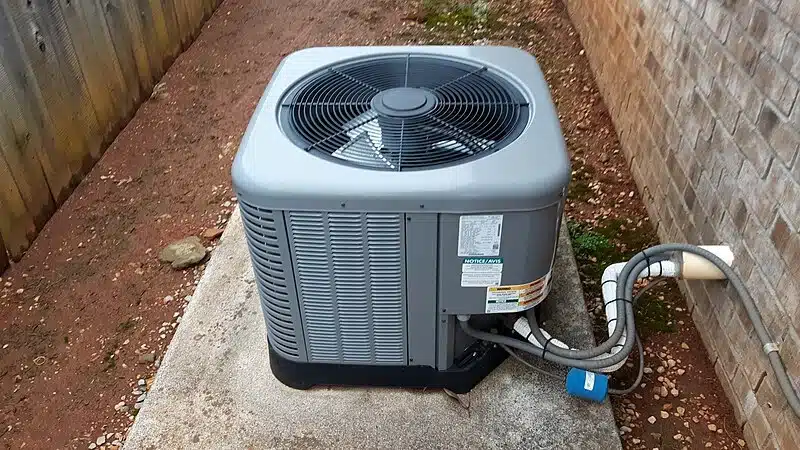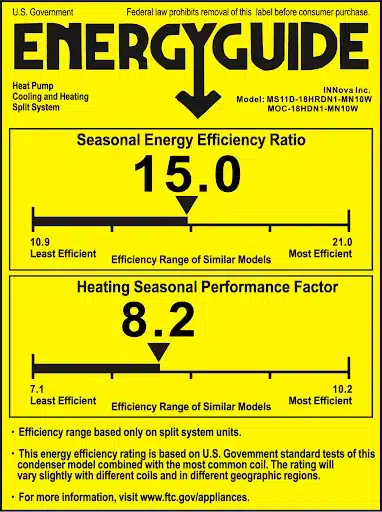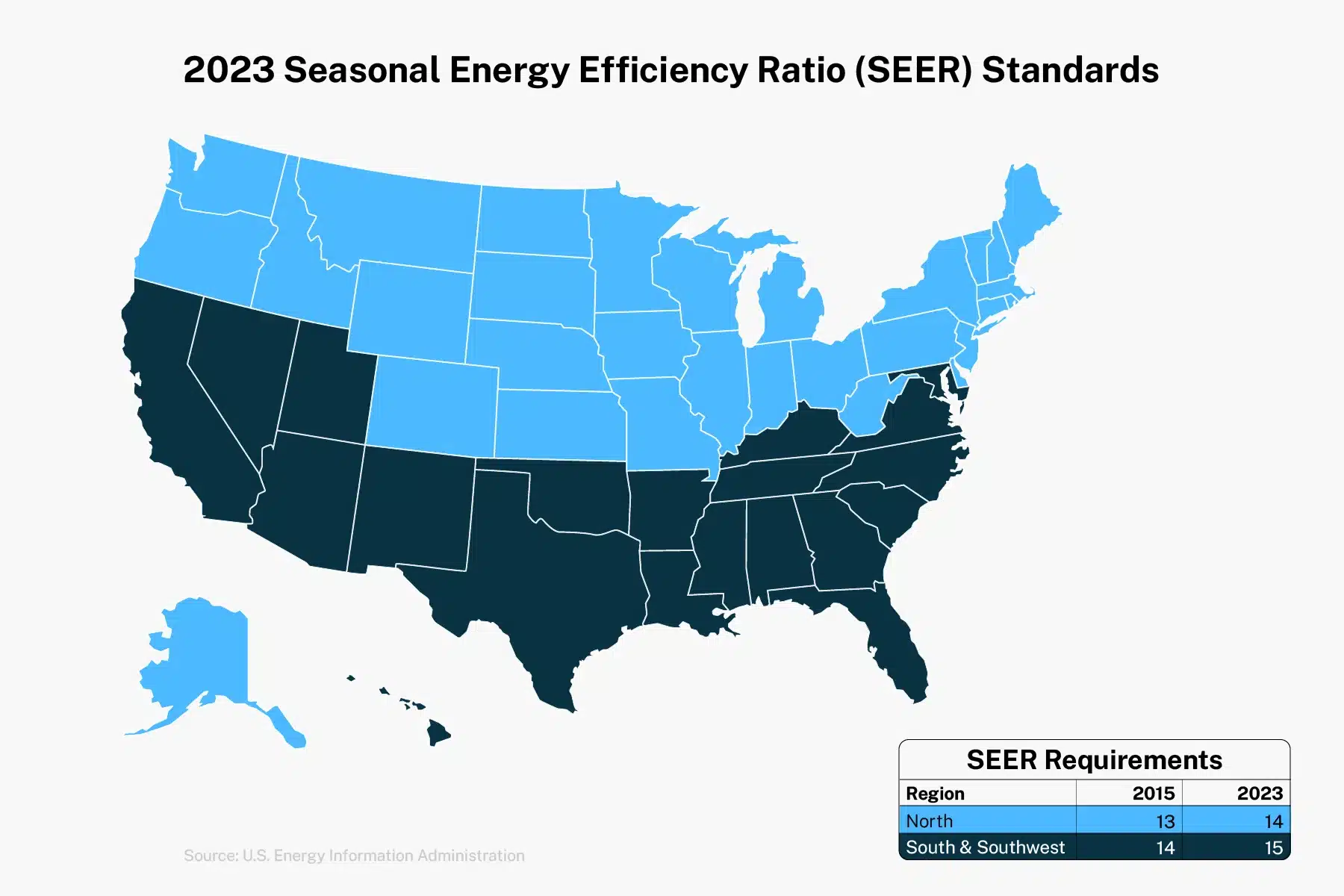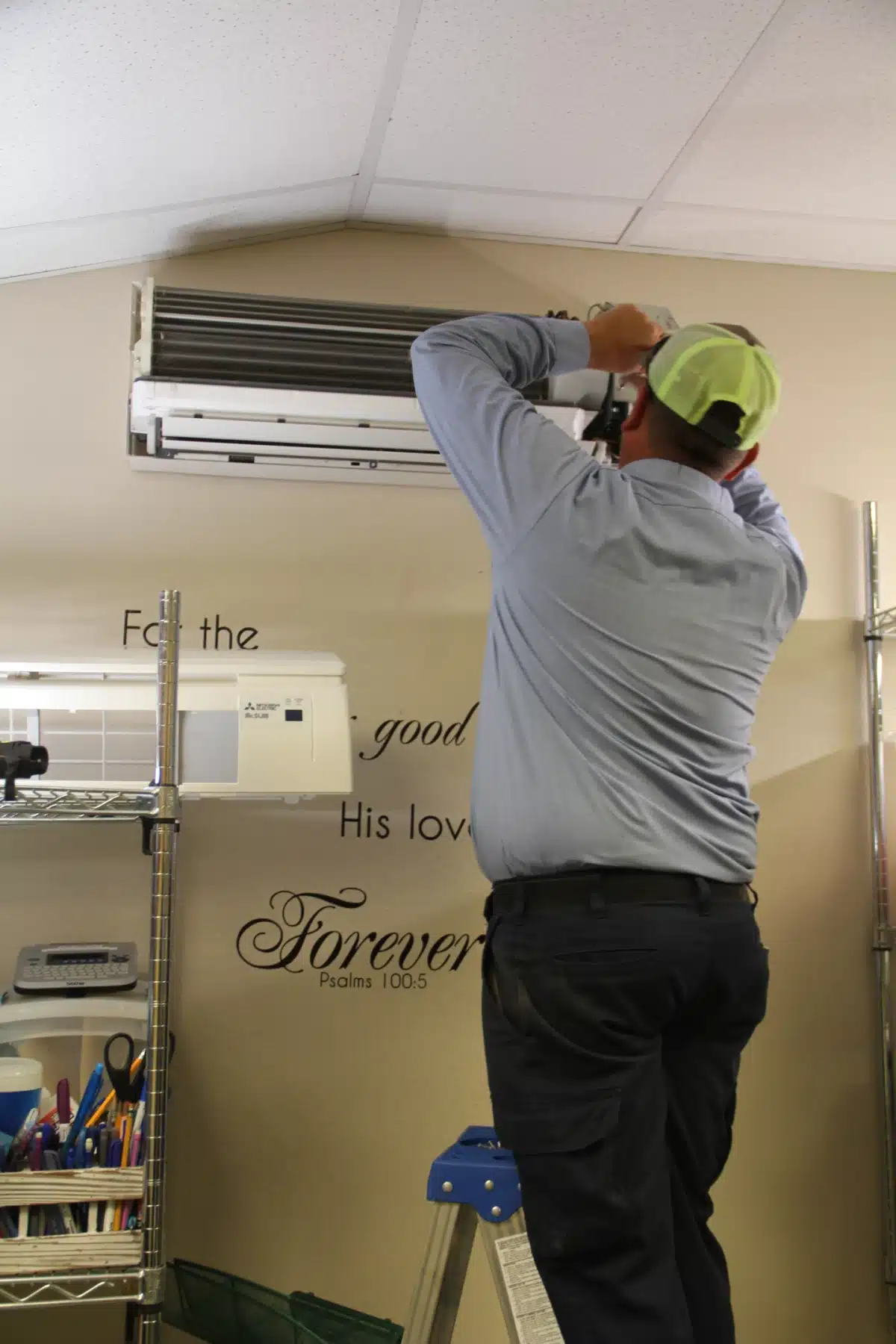Ah, the dreaded SEER rating – a term that often leaves homeowners scratching their heads in confusion. This blog will unravel this acronym and explain its significance in the world of air conditioning!
SEER Rating Definition
SEER stands for Seasonal Energy Efficiency Ratio (or Rating), and it’s a rating system used to measure the efficiency of your air conditioner or heat pump over an entire cooling season. Think of it as a miles-per-gallon rating, but for your AC unit instead of your car.
The higher the SEER rating, the more efficient your air conditioning system is at converting energy into cool, refreshing air.
Why Does SEER Matter?
You might be wondering, “Why should I care about this SEER thingy?” Well it’s all about saving those hard-earned dollars.
A higher SEER rating means your air conditioner will consume less energy to keep your home comfortable, resulting in lower monthly energy bills.
More efficient systems have a smaller carbon footprint, making them an eco-friendly choice for those looking to reduce their environmental impact.
Minimum SEER Requirements
Now, let’s talk about the rules and regulations surrounding SEER ratings. The U.S. Department of Energy (DOE) sets minimum SEER requirements for air conditioners and heat pumps, and these standards have been steadily increasing over the years.
Back in 1992, the minimum SEER rating was a modest 10. Fast forward to 2006, and it jumped to 13 for most of the country. But wait, there’s more! In 2015, the DOE decided to raise the bar even higher, setting the minimum SEER rating to 14 for the southern and southwestern states.
Starting in 2023, the northern states were also required to meet the 14 SEER minimum, while the southern and southwestern regions were told to hit a whopping 15 SEER.
The Efficiency Spectrum
Now that we’ve covered the basics, here are the ranges of Seasonal Energy Efficiency Rating available on the market.
14 SEER
This is the current minimum standard for most of the country, and it’s considered a good starting point for energy savings.
16 SEER
Step it up a notch, and you’ll find yourself in the realm of 16 SEER units. These are around 13-14% more efficient than their 14 SEER counterparts, saving you a decent chunk of change on those energy bills.
17 SEER and Above
These ultra-efficient systems are the best of the best in the air conditioning world. With advanced features like variable-speed compressors and modern fan motors, they can be up to 43% more efficient than a 14 SEER unit.
Balancing Upfront and Long-Term Expenses
Of course, with great efficiency comes a higher price tag. It’s the age-old dilemma: do you splurge on the top-of-the-line model, or do you opt for a more budget-friendly option?
A 16 SEER system might cost you an extra $900 to $1,500 compared to a 14 SEER unit. But remember, that upfront investment can pay off in the long run with energy savings.
If you’re feeling fancy and want to go all out with a 20 SEER or higher system, be prepared to shell out a pretty penny – ranging anywhere from $3,000 to $5,000 more than a standard 14 SEER model.
But here’s the kicker: higher SEER units also tend to have higher repair costs. So, while you might be saving on energy bills, you’ll want to factor in potential maintenance expenses down the line.
How Advanced Systems Work Their Magic
Now, let’s get a little technical. Many high-efficiency air conditioners and heat pumps employ a feature called a two-stage compressor.
Instead of simply turning on and off like a light switch, these bad boys have a low and high setting, allowing them to adjust their output based on your cooling needs.
These fancy systems also often come equipped with variable-speed blower fans, which can further enhance efficiency and reduce hot or cold spots in your home.
The Great SEER Divide
The DOE has decided to split the country into two sides when it comes to SEER requirements: the northern states and the southern/southwestern states.
In the southern and southwestern states, where the temperatures can soar, the DOE has mandated higher SEER minimums to help combat those sweltering conditions.
Meanwhile, in the northern states, where the weather is a little more mild (at least during the summer months), the SEER requirements have been a tad more lenient – until 2023, that is. That’s when the northern states had to step up their game and meet the same 14 SEER minimum as their southern counterparts.
Why Proper Setup Matters
Alright, now that this blog has weighed the pros and cons, there’s one more crucial factor to consider: proper installation.
Even the most advanced, top-of-the-line SEER system won’t perform at its peak if it’s not installed correctly.
That’s why it’s essential to work with a reputable, experienced HVAC professional who knows the ins and outs of air conditioner installation. They’ll take into account factors like your home’s size, insulation levels, ductwork, and more to ensure your new system is set up for success.
It’s worth the investment to have it done right the first time – you’ll save yourself a world of headaches (and potentially costly repairs) down the road.
Keeping Things Quiet and Comfortable
Alright, we’ve covered efficiency, cost, and installation – but what about noise levels? After all, no one wants to feel like they’re living next door to a jet engine every time their air conditioner kicks on.
A higher rated SEER system tends to be much quieter than a lower-rated HVAC system.
This is especially important if you have to place your outdoor unit near a bedroom window or if your neighborhood has strict noise regulations. No one wants to be that neighbor who keeps everyone awake with their loud, obnoxious air conditioner.
Keeping Your SEER System in Top Shape
After you’ve invested in a shiny new high-efficiency air conditioner, your SEER system will require regular maintenance to keep it running at peak performance.
Think of it like a well-oiled machine. Regular tune-ups, filter changes, and professional cleaning can go a long way in ensuring your system operates efficiently and extends its lifespan.
Plus, staying on top of maintenance can help you catch potential issues early on, saving you from costly repairs down the road.
Is a High SEER Rating Worth It?
This blog has covered a lot of ground – from the basics of SEER ratings to the nitty-gritty details of installation, maintenance, and everything in between. But the burning question remains: is a high SEER rating really worth the investment?
The answer, as with most things in life, is a resounding “it depends.” It all boils down to your specific circumstances, budget, and priorities.
If you’re looking for long-term energy savings and don’t mind shelling out a little extra upfront, a higher SEER system could be a wise investment. Just remember to factor in potential maintenance costs and work with a reputable HVAC professional to ensure proper installation.
On the other hand, if you’re working with a tighter budget or plan to move in the near future, a more modest 14 or 15 SEER unit might be the way to go. It’ll still provide decent energy efficiency without breaking the bank.
At the end of the day, the choice is yours. Just remember to do your research, weigh the pros and cons, and make the decision that best suits your unique needs and circumstances.
Your Partner in Air Conditioning Excellence
Speaking of reputable HVAC professionals, Diamondback AC – your trusted partner in all things air conditioning. With years of experience and a team of highly skilled technicians, is here to guide you through the process of selecting, installing, and maintaining the perfect SEER system for your home.
Whether you’re in the market for a budget-friendly 14 SEER unit or a top-of-the-line, ultra-efficient model, we’ve got you covered. Our team will take the time to understand your specific needs, preferences, and budget, and provide you with tailored recommendations to ensure you get the most bang for your buck.
But our services don’t stop there. We also offer plans to keep your new SEER system running smoothly for years to come. From tune-ups to prompt repairs, we’ve got your back every step of the way.
Give us a call today to schedule a consultation and take the first step towards air conditioning bliss. With Diamondback AC by your side, you can rest assured that your comfort and energy savings are in good hands.
Frequently Asked Questions
Is it worth going from 14 SEER to 16 SEER?
Upgrading from a 14 SEER to a 16 SEER air conditioning unit can offer moderate energy savings, making it a sensible investment for those in warmer climates or those who use their air conditioning frequently. The increase in energy efficiency can lead to cost savings on energy bills over time, helping to offset the higher upfront cost of the unit. For individuals prioritizing long-term savings and environmental impact, this shift could prove beneficial, especially in areas with high cooling demands.
How is SEER related to the cooling output?
SEER, or Seasonal Energy Efficiency Ratio, measures the ratio of cooling output over a typical cooling season divided by the energy consumed in watt-hours. It does not directly measure cooling capacity; instead, it indicates how efficiently a heating and cooling system uses electricity to produce cooling. Higher SEER ratings signify more efficiency, meaning less total electric energy input is used for the same amount of cooling. This efficiency translates to lower operational costs and reduced environmental impact over the lifetime of the unit.








